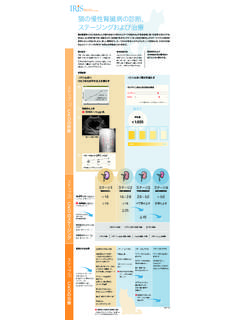Transcription of Diagnostic Update: Treatment Recommendations …
1 Diagnostic UPDATEIDEXX Reference Laboratories April 2011 Treatment Recommendations for feline Pancreatitis BackgroundPancreatitis is an elusive disease in cats and consequently has been underdiagnosed. This is owing to several factors. Cats with pancreatitis present with vague signs of illness, including lethargy, decreased appetite, dehydration and weight loss. Physical examination and routine laboratory findings are nonspecific, and until recently, there have been limited Diagnostic tools available to the practitioner for noninvasively diagnosing pancreatitis.
2 As a consequence of the difficulty in diagnosing the disease, therapy options are not well available, the SNAP fPL and Spec fPL tests can help rule in or rule out pancreatitis in cats presenting with nonspecific signs of illness. As our understanding of this disease improves, new specific Treatment modalities may emerge. For now, the focus is on managing cats with this disease, and we now have the tools available to more critically evaluate these cases. Placebo-controlled studies in people have revealed that the only Treatment strategies proven effective for pancreatitis are fluid therapy, pain management and nutritional support.
3 These are also the mainstay of therapy for treating cats with pancreatitis. Studies have shown, however, that approximately 2/3 of cats with pancreatitis have chronic disease for which Treatment Recommendations are less ,2 In addition, many cats are affected by concurrent illnesses ( , diabetes mellitus, hepatic lipidosis, cholangitis and inflammatory bowel disease).3 5 Diagnosis and management of both pancreatitis and concurrent conditions are critical to a successful Fluid TherapyIntravenous fluid therapy is key to supporting a patient with pancreatitis.
4 The main goal is to ensure that the pancreas is being adequately perfused. Initially, fluids should correct dehydration over the first 12 24 hours while also meeting maintenance needs and replacing ongoing losses of fluids from vomiting, diarrhea and third-space losses ( , peritoneal effusions secondary to pancreatitis). Acid-base and electrolyte abnormalities should be monitored closely and corrected. If hypocalcemia is noted in a cat with acute necrotizing pancreatitis, calcium gluconate should be given at doses of 50 150 mg/kg intravenously over 12 24 hours and serum total or ionized calcium concentrations should be monitored during therapy.
5 Colloids, such as dextran or hetastarch, can be used to support oncotic pressure, especially in patients that are hypoalbuminemic. Plasma therapy, although not as readily available for cats as it is for dogs, can be used if there is evidence of coagulopathy or disseminated intravascular coagulation (DIC). Pain ManagementAbdominal pain is frequently recognized in dogs with pancreatitis; however, it is rarely recognized in cats. Nonetheless, many cats will show clinical improvement if provided analgesic therapy. Because of this, many experts agree that pain management should be provided in all cats with acute pancreatitis.
6 Opioid therapy is recommended. Fentanyl transdermal patches have become popular for pain relief because they provide a longer duration of analgesia. It takes at least 6 hours to achieve adequate fentanyl levels for pain control; therefore, one recommended protocol is to administer another analgesic, such as intravenous buprenorphine, at the time the fentanyl patch is placed. The cat is then monitored closely to see if additional pain medication is required. Cats with chronic pancreatitis may also benefit from pain management, and options for outpatient Treatment include a fentanyl patch, sublingual buprenorphine, oral butorphanol or TherapyVomiting, a hallmark of pancreatitis in dogs, may be absent or intermittent in cats.
7 When present, vomiting should be controlled; and if absent, Treatment with an antiemetic should still be considered to treat nausea. There are several antiemetics available. Metoclopramide (Reglan ) is a popular antiemetic in cats and is still used by many practitioners. However, metoclopramide is a dopamine antagonist and inhibits vomiting by blocking the central nervous system (CNS) dopamine receptors in the chemoreceptor trigger zone (CRTZ). It is probably not a very good antiemetic in cats because they are reported to have few CNS dopamine receptors in the CRTZ.
8 Dolasetron (Anzemet ) and ondansetron (Zofran ) act on the serotonin 5-HT3 receptors in the CRTZ and are very effective in cats. Lastly, although maropitant citrate (Cerenia ) is only labeled for use in dogs, it has become a popular and effective antiemetic for use in cats and acts on the neurokinin (NK) receptors in the vomiting center and can be used at 1/2 of the dog dose. Nutritional Support Experts recommend enteral nutritional support in all patients with pancreatitis. The historical recommendation of nothing per os (NPO) for animals with pancreatitis is no longer accepted.
9 In addition, cats can develop hepatic lipidosis if not provided adequate calories. The new dogma has become this: if the gastrointestinal tract works, use it; and if the patient is vomiting, give an antiemetic so that they keep the food down. Enteral nutrition stabilizes the gastrointestinal barrier, improves enterocyte health and immune function, improves gastrointestinal motility, prevents catabolism and decreases morbidity and mortality. Cats with pancreatitis are inappetant; therefore, ingestion of adequate calories is rare. Force feeding is not recommended because it is difficult to achieve the appropriate level of caloric intake, and force feeding can also lead to food Enteral nutrition can be provided by a variety of feeding tubes, including nasogastric, nasoesophageal, esophagostomy, gastrostomy or jejunostomy tubes.
10 If vomiting cannot be controlled, then partial parenteral nutrition (PPN) or total parenteral nutrition (TPN) can be provided to meet some or all of the patient s caloric needs. TPN is typically only available in 24-hour care facilities, but PPN is more user-friendly and practical for use in any practice. However, although parenteral nutrition supports the patient s caloric needs, it doesn t nourish the enterocytes. Therefore, some specialists recommend providing microenteral nutrition by trickle feeding through a feeding tube to provide nourishment to the gastrointestinal tract.




